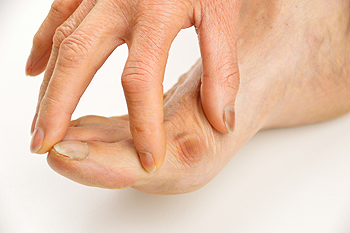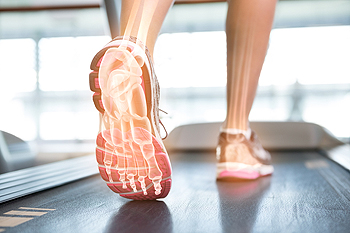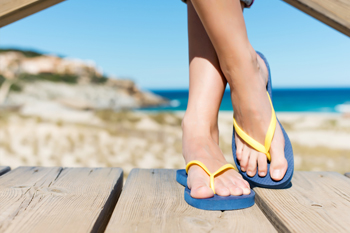Items filtered by date: September 2020
Possible Relief Methods For Bunions
 A bunion is defined as a bone that grows on the side of the big toe. It is often a nuisance, and wearing shoes may become difficult. Symptoms can include redness, swelling, and corns that may form on top of the bunion as a result of excess friction. The common reason patients may develop bunions is wearing shoes that do not have adequate room for the toes to move freely in, or bunions may form due to genetics. Some patients find mild relief when a protective pad is worn over the bunion, and when supportive shoes are worn. Additionally, wearing custom made orthotics may bring the relief that is needed. In severe cases, surgery may be an option to consider for permanent removal. If you have bunions, it is suggested that you visit a podiatrist.
A bunion is defined as a bone that grows on the side of the big toe. It is often a nuisance, and wearing shoes may become difficult. Symptoms can include redness, swelling, and corns that may form on top of the bunion as a result of excess friction. The common reason patients may develop bunions is wearing shoes that do not have adequate room for the toes to move freely in, or bunions may form due to genetics. Some patients find mild relief when a protective pad is worn over the bunion, and when supportive shoes are worn. Additionally, wearing custom made orthotics may bring the relief that is needed. In severe cases, surgery may be an option to consider for permanent removal. If you have bunions, it is suggested that you visit a podiatrist.
If you are suffering from bunion pain, contact Dr. John P. Beaupied of Palos Podiatry. Our doctor can provide the care you need to keep you pain-free and on your feet.
What Is a Bunion?
Bunions are painful bony bumps that usually develop on the inside of the foot at the joint of the big toe. As the deformity increases over time, it may become painful to walk and wear shoes. Women are more likely to exacerbate existing bunions since they often wear tight, narrow shoes that shift their toes together. Bunion pain can be relieved by wearing wider shoes with enough room for the toes.
Causes
- Genetics – some people inherit feet that are more prone to bunion development
- Inflammatory Conditions - rheumatoid arthritis and polio may cause bunion development
Symptoms
- Redness and inflammation
- Pain and tenderness
- Callus or corns on the bump
- Restricted motion in the big toe
In order to diagnose your bunion, your podiatrist may ask about your medical history, symptoms, and general health. Your doctor might also order an x-ray to take a closer look at your feet. Nonsurgical treatment options include orthotics, padding, icing, changes in footwear, and medication. If nonsurgical treatments don’t alleviate your bunion pain, surgery may be necessary.
If you have any questions, please feel free to contact our office located in Palos Heights, IL . We offer the newest diagnostic and treatment technologies for all your foot care needs.
Poor Foot Biomechanics
 There are a variety of biomechanical issues in the feet that can lead to potential injury. Some of these issues include fallen arches, over-pronation, or supination. Pronation occurs when the foot rolls inward at the ankle, the midfoot bulges and the arch flattens. Supination occurs when the foot rolls out at the ankle and the arch is raised, which leads to issues absorbing shock. When poor foot biomechanics can cause specific foot injuries such as plantar fasciitis, Achilles tendonitis, or a Morton’s neuroma, pain in the ankles, heels, and arches is a common result. Poor foot biomechanics can also lead to issues in other parts of the body that include knee pain, hip pain, shin splints and lower back pain. If you are concerned about your foot biomechanics, consult with a podiatrist.
There are a variety of biomechanical issues in the feet that can lead to potential injury. Some of these issues include fallen arches, over-pronation, or supination. Pronation occurs when the foot rolls inward at the ankle, the midfoot bulges and the arch flattens. Supination occurs when the foot rolls out at the ankle and the arch is raised, which leads to issues absorbing shock. When poor foot biomechanics can cause specific foot injuries such as plantar fasciitis, Achilles tendonitis, or a Morton’s neuroma, pain in the ankles, heels, and arches is a common result. Poor foot biomechanics can also lead to issues in other parts of the body that include knee pain, hip pain, shin splints and lower back pain. If you are concerned about your foot biomechanics, consult with a podiatrist.
If you have any concerns about your feet, contact Dr. John P. Beaupied from Palos Podiatry. Our doctor can provide the care you need to keep you pain-free and on your feet.
Biomechanics in Podiatry
Podiatric biomechanics is a particular sector of specialty podiatry with licensed practitioners who are trained to diagnose and treat conditions affecting the foot, ankle and lower leg. Biomechanics deals with the forces that act against the body, causing an interference with the biological structures. It focuses on the movement of the ankle, the foot and the forces that interact with them.
A History of Biomechanics
- Biomechanics dates back to the BC era in Egypt where evidence of professional foot care has been recorded.
- In 1974, biomechanics gained a higher profile from the studies of Merton Root, who claimed that by changing or controlling the forces between the ankle and the foot, corrections or conditions could be implemented to gain strength and coordination in the area.
Modern technological improvements are based on past theories and therapeutic processes that provide a better understanding of podiatric concepts for biomechanics. Computers can provide accurate information about the forces and patterns of the feet and lower legs.
Understanding biomechanics of the feet can help improve and eliminate pain, stopping further stress to the foot.
If you have any questions please feel free to contact our office located in Palos Heights, IL . We offer the newest diagnostic and treatment technologies for all your foot and ankle needs.
Plantar Warts Can Be Treated!
Foot Problems Associated with Flip-Flops
 Flip-flops are popular summer footwear for their ease and comfort, but did you know that wearing flip-flops can be detrimental to your foot health? Because of their generally flimsy structure and lack of cushioning, wearing flip-flops can lead to a variety of foot problems. Plantar fasciitis, the inflammation of the tissue that runs along the bottom of the foot, can be caused by wearing flip-flops as they do not provide arch support. Tendinitis, inflammation or irritation of the tendons located on either side of your ankles, is another common condition that can be caused by flip-flops. Flip-flops create instability in your ankles when you walk, which makes an injury more likely. Metatarsalgia, pain in the bottom of the foot, can also be caused by wearing flip-flops, as these completely flat shoes do not cushion your feet from the pounding and pressure exerted on your joints as you walk. If you are experiencing foot problems, it is recommended that you seek the care of a podiatrist.
Flip-flops are popular summer footwear for their ease and comfort, but did you know that wearing flip-flops can be detrimental to your foot health? Because of their generally flimsy structure and lack of cushioning, wearing flip-flops can lead to a variety of foot problems. Plantar fasciitis, the inflammation of the tissue that runs along the bottom of the foot, can be caused by wearing flip-flops as they do not provide arch support. Tendinitis, inflammation or irritation of the tendons located on either side of your ankles, is another common condition that can be caused by flip-flops. Flip-flops create instability in your ankles when you walk, which makes an injury more likely. Metatarsalgia, pain in the bottom of the foot, can also be caused by wearing flip-flops, as these completely flat shoes do not cushion your feet from the pounding and pressure exerted on your joints as you walk. If you are experiencing foot problems, it is recommended that you seek the care of a podiatrist.
Flip-flops are not always the best choice of footwear. If you have any concerns about your feet or ankles, contact Dr. John P. Beaupied from Palos Podiatry. Our doctor will assist you with all of your foot and ankle needs.
Flip-Flops and Feet
When the weather starts warming up, people enjoy wearing flip-flops. Flip-flops are comfortable, stylish, and easy to slip on and off; they're perfect for any summer beach goer. However, these shoes can cause harm to the feet.
How Can Flip-Flops Affect Me Long-Term?
- Ankle problems
- Hip problems
- Lower back problems
- Pain in the balls of the feet
- Problems with foot arches
- Changes in the way you walk
Are There Injuries Associated with Flip-Flops?
Yes. Since flip-flops are relatively weak and do not provide the same amount of support as sneakers, people who wear flip-flops regularly are more susceptible to injuries. On top of that, the open nature of the shoe makes your feet more prone to other problems, such as cuts and even infections. Common injuries and ailments include:
- Sprained ankles
- Blisters
- Infections
- Cuts and Scrapes
I like Wearing Flip-Flops. Are There Safe Alternatives?
When buying flip-flops, try to find ones that have sturdy soles and that are made of high-quality materials that will support for your feet. These flip-flops will cost more but will also last longer as a result.
If you have any questions please feel free to contact our office located in Palos Heights, IL . We offer the newest diagnostic and treatment technologies for all your foot and ankle needs.
What Is an Ingrown Toenail?
 Patients who have ingrown toenails are often aware of the pain and discomfort they may cause. It occurs as a result of the outer edge of the nail digging into the surrounding skin, and generally affects the big toe. Common causes of ingrown toenails can include improperly trimming the toenails, in addition to wearing shoes that do not have adequate room for the toes to move freely in. Mild relief may be found when the affected foot is soaked in warm water, and the nail is gently pulled away from the skin. If you are afflicted with an ingrown toenail, it is recommended that you consult with a podiatrist as quickly as possible, who can effectively treat this condition, and offer prevention techniques.
Patients who have ingrown toenails are often aware of the pain and discomfort they may cause. It occurs as a result of the outer edge of the nail digging into the surrounding skin, and generally affects the big toe. Common causes of ingrown toenails can include improperly trimming the toenails, in addition to wearing shoes that do not have adequate room for the toes to move freely in. Mild relief may be found when the affected foot is soaked in warm water, and the nail is gently pulled away from the skin. If you are afflicted with an ingrown toenail, it is recommended that you consult with a podiatrist as quickly as possible, who can effectively treat this condition, and offer prevention techniques.
Ingrown toenails may initially present themselves as a minor discomfort, but they may progress into an infection in the skin without proper treatment. For more information about ingrown toenails, contact Dr. John P. Beaupied of Palos Podiatry. Our doctor can provide the care you need to keep you pain-free and on your feet.
Ingrown Toenails
Ingrown toenails are caused when the corner or side of a toenail grows into the soft flesh surrounding it. They often result in redness, swelling, pain, and in some cases, infection. This condition typically affects the big toe and may recur if it is not treated properly.
Causes
- Improper toenail trimming
- Genetics
- Improper shoe fitting
- Injury from pedicures or nail picking
- Abnormal gait
- Poor hygiene
You are more likely to develop an ingrown toenail if you are obese, have diabetes, arthritis, or have any fungal infection in your nails. Additionally, people who have foot or toe deformities are at a higher risk of developing an ingrown toenail.
Symptoms
Some symptoms of ingrown toenails are redness, swelling, and pain. In rare cases, there may be a yellowish drainage coming from the nail.
Treatment
Ignoring an ingrown toenail can have serious complications. Infections of the nail border can progress to a deeper soft-tissue infection, which can then turn into a bone infection. You should always speak with your podiatrist if you suspect you have an ingrown toenail, especially if you have diabetes or poor circulation.
If you have any questions, please feel free to contact our office located in Palos Heights, IL . We offer the newest diagnostic and treatment technologies for all your foot care needs.




